ę March 2005 | Main | May 2005 Ľ
April 29, 2005
if at first you don't succeed
For those of you following the unfolding story of the frustrations of capturing a likeness, here's the latest attempt:
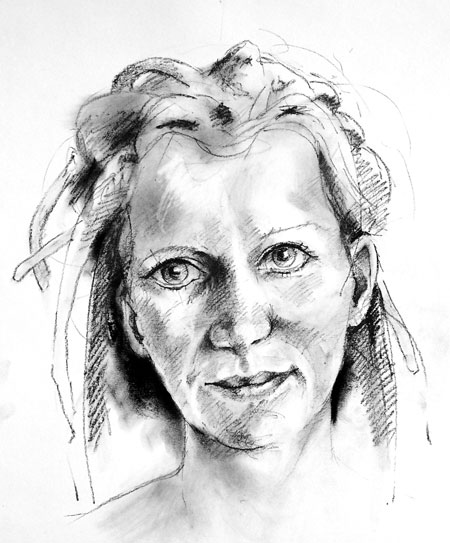
Giving weight to the argument that if at first you don't succeed ... go and live in a cave in Scotland and watch spiders. or something like that. Jim Dine said that if he did a good drawing he would often rub it out and do another because it would be even better the second time. That takes guts.
Posted by john at 10:59 AM | Comments (0) | TrackBack
April 26, 2005
closer to you
The paint builds up. The tones get closer and you rise up out of the canvas
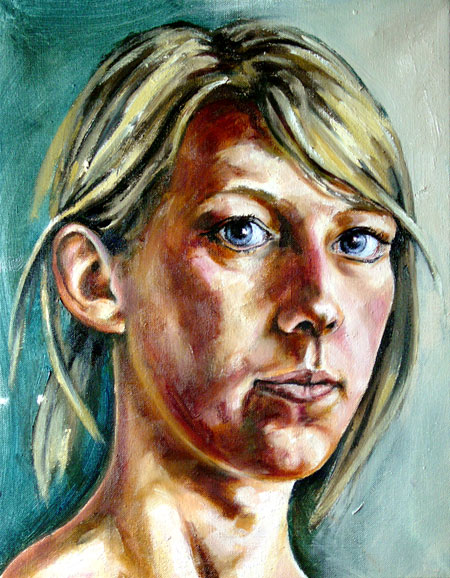
Posted by john at 07:15 PM | Comments (0) | TrackBack
verdigris

from: Every Young Man's Companion, by W. Gordon Teacher of Mathematics. Third edition [corrected, with Large Additions] 1759
Posted by john at 02:12 PM | Comments (0) | TrackBack
April 25, 2005
three things
Three things are important for a good painting or drawing.
I can do a passable drawing pretty much most of the time. I can do an acceptable painting if I set my mind to it. But to get the drawing that stands out, to get the painting that is more than just paint on panel. To get IT in other words; three things are needed.
First a degree of skill in handling the medium. Itís no good trying to do something without the tools. Secondly a passionate inspiration, I believe only good work will come from something you are really fired up about. Thirdly and perhaps most important of all, the right frame of mind.
The wrong frame of mind can make me too hesitant and produce flat dull marks. A frame of mind where Iím frightened or in awe of my ideas and inspiration will produce hesitant marks. Too much confidence and the pudding gets too many eggs in it, the marks tend to be heavy handed and obscure the passion.
The moments where the frame of mind is just right are few and far between, they cannot be planned or just switched on. Hence the clichť of the artistís muse descending. I am slowly learning how to set up circumstances which encourage the right frame of mind, and allow the muse to descend and settle on my shoulder, if indeed that is where muses settle.
Posted by john at 03:52 PM | Comments (0) | TrackBack
April 24, 2005
burnt umber

from: Every Young Man's Companion, by W. Gordon Teacher of Mathematics. Third edition [corrected, with Large Additions] 1759
Posted by john at 04:07 PM | Comments (0) | TrackBack
April 21, 2005
Nearly getting you
And again.
You talk
you smile
you laugh
you move through the light.
There is an essence of you
I like
and I ask to draw you.
And you sit
and I try and get you.
\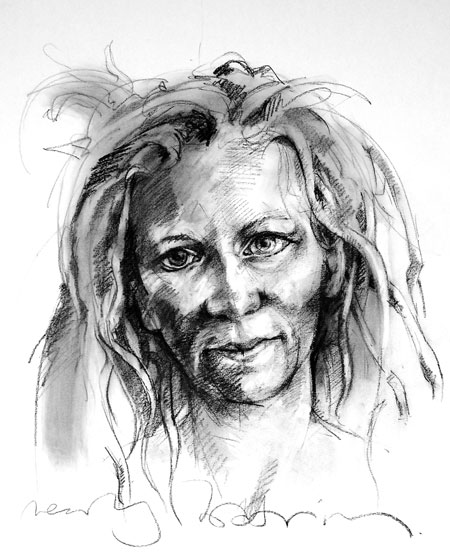
But I donít get what I saw
because I didnít see you sitting still;
so even though I begin to see you
I donít see what I saw
Then
we have a break
you move
I see what I saw again
and that helps.
I move
you talk
I keep making marks
you smile you laugh
I get more of you.
Maybe next time
itíll be the you I saw
that I see.
Posted by john at 06:12 PM | Comments (0) | TrackBack
April 20, 2005
Getting you
First thing in a portrait: I try and put the shape down. All important Ė if the shape, the outline, works then the head is on to a good start. Then I begin to find the form, breaking into the shape to find the way the features are. Weíve all got two eyes, a nose and a mouth, yet we all look remarkably different. Unless you come from the other side of the world, in which case apparently we all look alike [and smell of milk].
So I have to know how to arrange the paint on the surface to make a passing resemblance of an eye or a nose or, most difficult of all: a mouth. But thatís not all, it has to be your eyes, your nose, your mouth. I have to immerse myself in your face. I have to see your features moving, animating, smiling, laughing, talking and just sitting looking at things. I have to try and capture you. Something about your own particular collection of features and expressions that is the you of you.
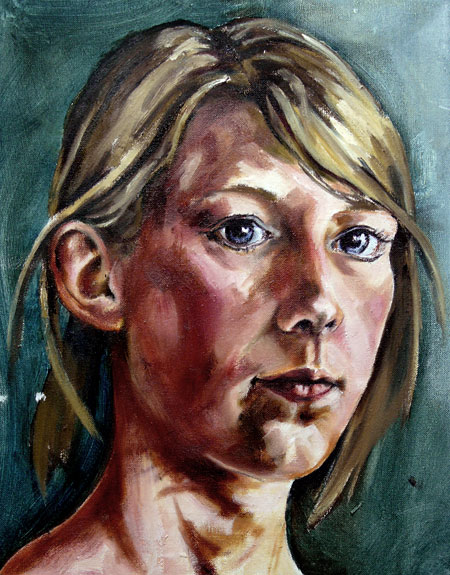
I canít just go from A to B with it. I canít just start at the top of the painting and work my way down to the bottomÖda da de dah Ė there!
It doesnít work like that. I load the canvas with paint then begin to push the light and dark tones about a bit. Old marks and colours left behind as I add and subtract tones mix with the new marks and the painting starts to come alive. Time is important. Time looking, time painting, not trying to Ďfinishí it, just trying to catch the light before it dashes off.
Posted by john at 10:49 AM | Comments (0) | TrackBack
April 18, 2005
In amongst the ashes
Like the small child scrabbling round in the hearth, Iíve been blackening my fingers tackling the charcoal and struggling with a big head.
After four days of enforced cleanliness Ė framing and mounting work for exhibition, I got grubby yesterday. A big head:
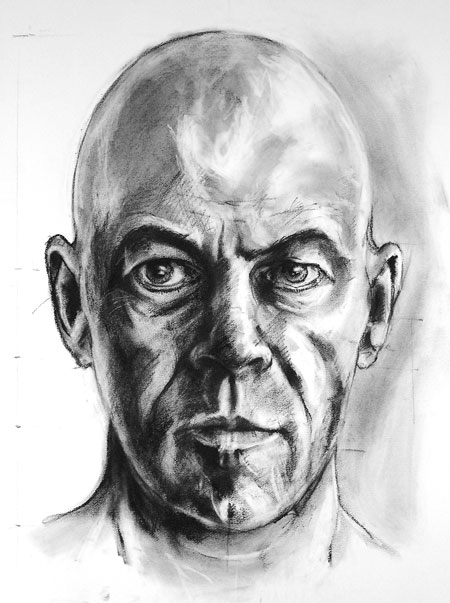
Not as big as the big figure below, but still big, and in fact the head is bigger than the head on the big figure, coming in at 760mm x 560mm, which is a few pounds short of a bushel. If the head were to be atop a figure I guess the figure would stand some 4.2 metres tall. [using the Greek formula that the figure stands seven heads high.] That's a lot of charcoal, not to mention a huge piece of paper.
Mounting and framing and titling and cataloguing and pricing and packing pictures are not my favourite activities. I know the importance of good mounting and framing: it shows you take yourself and your work seriously. But itís mind-bogglingly tricky stuff, all those measurements and figures and decisions, and what shall I call it?
ďOh, Iíve already got one called that, damn!Ē
Posted by john at 03:23 PM | Comments (0) | TrackBack
April 14, 2005
Hanging your pants out in public
Oh, itís all very well struggling with my passions, and wrestling with my skills and eventually turning out a few paintings. But then people want to see them. People want me to exhibit them.
So I have to choose which pictures to hang. And if thatís not bad enough they'll want to know how much they cost.
These are impossibilities, though they are impossibilities that have to be overcome - okay so they're not impossibilities [if they were impossible I couldn't overcome them, could I?] they are difficulties, difficulties that have to be overcome, in my case: today, as I have to deliver work to The Art House for an exhibition [24th April to 21st May], tomorrow.
As Iíve said before: painter I may be salesman I ainít.
Posted by john at 11:36 AM | Comments (0) | TrackBack
April 13, 2005
a problem of scale
I canít paint small. I can draw fairly small, but I like to draw big too.
This is difficult because the results are unfeasibly big, making framing, transport and exhibiting a nightmare.
Life-size is great, larger than life is fantastic. This is over eight feet tall [two thousand four hundred and forty of the new metric millimetres]
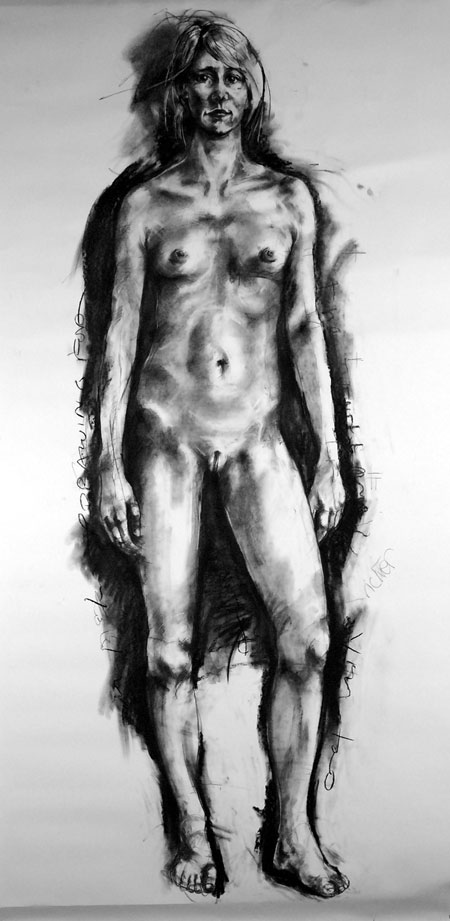
Working big is more like sculpture. I can lay on the charcoal then cut it back, then lay it on again; working the form with soft charcoal pastels, erasers and rags, as will as my hands and fingers. Itís a physical thing, an open, dynamic, process.
Working small is all tight and screwed up and pinched and anal. A whole different ball game.
Click here for an idea of the scale.
Posted by john at 12:53 PM | Comments (0) | TrackBack
April 12, 2005
Learning to forget
Or, to put it another way: unconsciously adopting learnt techniques.
Iíve got to know how to do it, for my own piece of mind. The mechanic in me demands the knowledge. But then the artist in me screams to let go, get into the groove, relax in the moment [heaven forbid, even enjoy it] and just paint.
When youíre four you just paint. There: ďMUMMY,Ē he says, pointing to a mass of squiggles on the page. And he has no doubt that it is his mother. And it is.
Then he looks up, goes to school and notices the apparent perfection of the world around him and suddenly he canít draw Mummy any more.
Picasso said he spent years and years trying to draw again like a child. The innocence and certainty are pure expression. Though it is hard to justify the squiggles when youíre older. ďHe should know better!Ē He knows too much already.
I fall foul of technique all too often, and need distractions [see below] to help me forget and just get on with the business of seeing and making marks.
Posted by john at 11:02 AM | Comments (0) | TrackBack
distractions
Loud music
Books on tape
Radio plays
A wee drop of Red Agony whiskey
Talking to the model
Too much black coffee
Bare feet
Posted by john at 10:55 AM | Comments (0) | TrackBack
April 08, 2005
The plasticine effect.
Itís not strictly true that flake white and transparent red oxide donít mix [see below: "things that don't mix"], they do mix but they make the palette a revolting pinky brown and generally unpleasant.
Mixing colours is a tricky business, a business where the axiom Less is More is apposite. There are only, basically, three colours Ė okay, okay, Winsor & Newton have 100 colours, Dulux Matchmaker can mix you 16,000 different colours and Epson say they produce three and a half million with their top of the range printers BUT these are just mixtures of the three basic colours. The colours are RED, BLUE & YELLOW. [Weíll talk about black and white at a later date]
Red, Blue and Yellow are the PRIMARY COLOURS, mix these guys in pairs and you get ORANGE, GREEN & PURPLE: the SECONDARY COLOURS.
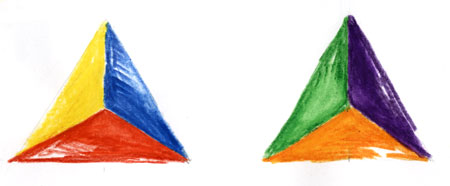
Put all these colours in a circle: RED, PURPLE, BLUE, GREEN, YELLOW, ORANGE, and BINGO! youíve got yourself a colour wheel.
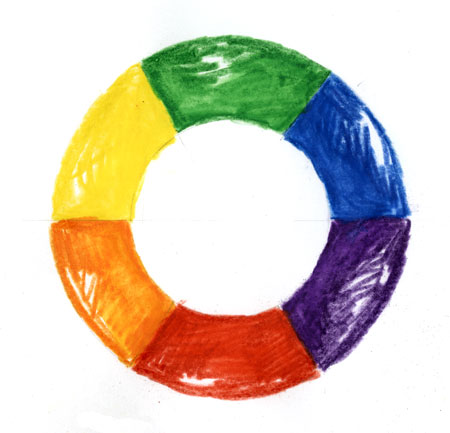
Now we get to the tricky bit: The Plasticine Effect. If you mix all three primary colours you get BROWN. Not pleasant-warm-new-conker brown, or deep-dark-mysterious-nearly-black brown, but yucky-sludgy-just-come-out-of-the-wrong-end-of-a-cow brown. Shitty brown in simple terms. The colour your Plasticine always ended up. So never mix three colours together, in similar quantities, as they will always tend towards the more unpleasant variety of brown.
The colours opposite each other on the colour wheel are called COMPLIMENTARY COLOURS and are party to their own set of rules, not a few of which crop up in our daily lives with sayings like ďRed and green should never be seenĒ. Basically complimentary colours vibrate when put next to each other. Much used by the Op Artists. They are useful for dramatic effects in painting.
Complimentary colours are made up of all three primaries, in that they are usually a primary and a secondary, therefore they contain all three primary colours so: never mix complimentary colours together or youíll get a turd on your palette.
A simple rule: mix two colours then Ďbreakí it with a third. That is: use a good dollop of two colours, then a just a touch of a third. This way leads to the many colours we see around us.
Of course in American there are NO colours Ė theyíre all colors, but their cause is not ours.
Posted by john at 09:21 AM | Comments (0) | TrackBack
Things that donít mix
Greasy hands and charcoal
Chalk and cheese
Wet hands and graphite
White wine and whiskey
Oil and water
Turpentine and cake [donít ask]
Tea and turps substitute [againÖ]
Flake white and transparent red oxide
Posted by john at 08:23 AM | Comments (0) | TrackBack
April 07, 2005
the days in between
And then there are the days when nothing happens.
The days in between.
When there are panels primed, when there are panels half painted, when there are stacks of drawings ready to be taken further. But I just canít summon the energy. The days drag by. There is so much I could do, but I donít. I donít do anything. Or rather I do everything but.

These are gestating periods perhaps, before the shame and frustration is too much and I force myself to work. Then a whole lot splurges out at once.
Itís not nine-to-five in the Oil Painting Industry, you canít just sit down and do a few hours' work, and it doesnít stop at six oíclock. I donít pack up and leave my work behind. Itís an emotional thing that I get involved with. It strikes at the most unlikely times.
Posted by john at 11:18 AM | Comments (0) | TrackBack
April 06, 2005
After the primer
Then the drawings start to be compared: which drawing Ė which pose Ė do I want to paint? Which works best?
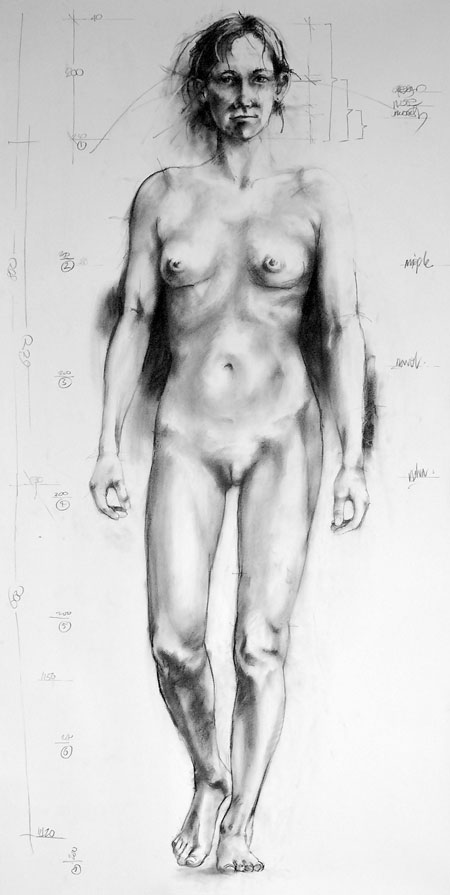
The painting is a huge commitment in time and money; a handicap in many ways, as it limits my choice. I donít have the time or money to paint all the pictures I want to paint. So I have to select certain poses, certain pictures, certain compositions. And I want to paint them all Ė and more besides.
ďWell, paint smaller!Ē
ďIíve tried.Ē
ďIt wonít take so much paint.Ē
ďI canít do it smaller.Ē
ďAnd itíll be quicker.Ē
But, I canít paint smaller, Iíve tried, but the scale-ruler in my brain has been mislaid. Itís life size or larger [largerís great but thatís well big, very expensive, time consuming and wholly impractical.]
So I have to choose, like trying to choose a tattoo: which picture gets to be painted? Sometimes I get it wrong. And then, no matter how good the painting Ė the application of the paint, the brush strokes, the colours, the tones, the textures Ė if the composition and pose donít work, the whole thing doesnít work.
maybe I'll choose this one, maybe I won't [I suspect I won't]
ps: even the drawings are nearly lifesize - that's a whole lot of charcoal [and very dirty fingers]
Posted by john at 02:18 PM | Comments (0) | TrackBack
April 05, 2005
Decisions decisions
Oh, itís a good break, you think. Itíll be good to get into something purely practical. There are four panels and they each need five coats of white primer. The five coats of white primer is just pushing paint. Itíll be good not to have so many decisions to make.
But it ainít that simpleÖ
Do I lay the primer on with energetic random strokes?
Do I find a rhythm, and so risk a pattern?
Do I go up and down?
Or side to side?
Do I follow the grain?
Or go against it?
Should it be smooth and even?
Or rough and ready?
Do I sand down between coats?
Or not?
Do I leave that bit sticking up?
Hell, Iím only on the primer and Iím exhausted.
Answers: yes, no, both [lay it on against the grain, lay it off with the grain], no, rough and ready, no, yes.
Posted by john at 03:20 PM | Comments (0) | TrackBack
April 02, 2005
white primer
This is where it all starts, the white primer. Quick drying acrylic white primer to be more precise. I paint on wood because of its resistance. Canvas stretched over two metres tends to give, in a sort of slurr, which I donít want. Imprecision is one thing, but slurring Ė no.
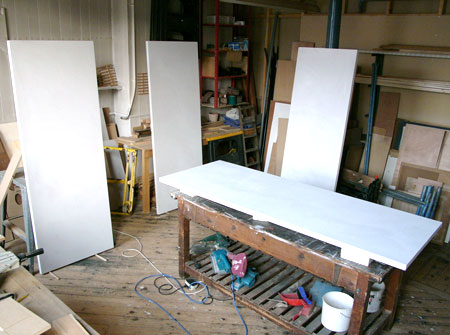
So I paint on wood. Wooden panels. Marine ply when I can get it. And more recently, for the standing figures: doors, flush doors. I sand them down [with a heavy sanding machine] then I paint them white. And white, and white. Five coats of white on the side that Iím painting on.
Posted by john at 05:30 PM | Comments (0) | TrackBack